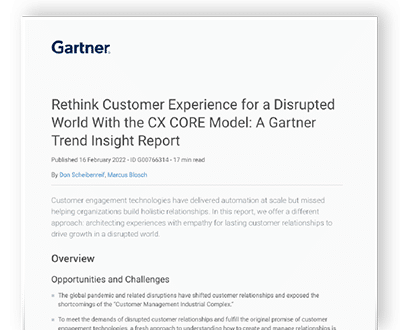Getting Experience Data to Stay Customer Centric with Contactless Service
Published on Apr 26, 2022

While businesses adapt to a late-pandemic marketplace, it’s imperative to keep pace with a quickly evolving customer experience. As the expectations for low-contact or contactless shopping evolve from necessity to preferred convenience, your digital touchpoints still need to hit the mark.
Here are 3 things you can do today to ensure your brand is getting the feedback necessary to meet customer expectations with contactless service.
1. Providing Intuitive Feedback Options
More than ever, customers expect and deserve a user-friendly, frictionless contactless service experience. By offering touchpoints for consumers to provide your brand with solicited and unsolicited feedback regarding your digital experience, you can gain real-time insights into what works and what doesn’t when it comes to your website or mobile app. The options for gathering this kind of feedback include:
Open-Ended Feedback Tab
An always-on feedback tab gives customers the opportunity to tell you about their stellar and less-than-stellar experiences with certain processes, pages, or your site in general. Maybe a loyal, repeat customer is struggling to book a service or appointment slot online they typically book in store, or a first-time user hits a roadblock while trying to use contactless ordering. Whether positive or negative, unsolicited feedback goes the extra mile to answer the questions you hadn’t thought to ask and provide insight to issues you didn’t know existed.
Self-Service Digital Comment Cards
To lessen the strain on your customer care team, your “Contact Us” page should have an intuitive feedback channel included. Brands can gain higher-level brand insights (as opposed to specific usability issues with the feedback tab) during a time location-level feedback might not be feasible. These pages help centralize both negative and positive feedback and make it easier for customer care teams to prioritize customer engagement efforts.
Website Surveys
Intuitive site-intercept surveys nudge consumers for feedback during various stages of the purchasing or scheduling process. Brands can decide which pages or specific behaviors trigger the survey, allowing them to measure discrete, isolated experiences. By configuring survey invitation criteria to capture feedback and critical points in the digital journey, you can surface more targeted insights and design a user experience optimized for conversion at each step of the purchase decision funnel.
At a time when more purchase journeys are contactless or entirely online, real-time feedback can help you get the information you need to provide a simpler, stress-free shopping experience for consumers.

Reset your CX strategy for loyalty by re-focusing on customer empathy
2. Measuring Beyond Checkout
Speedy delivery has been a hot topic for years—but for many brands, priorities shifted amid the global pandemic. Even Amazon, a pioneer of the two-day delivery trend, is pushing out estimated delivery windows on non-essential items. Brands that typically compete with the retail giant for customers are now able to get products out faster—and they’re seizing the opportunity.
As online orders surge, it’s important to remember the digital experience doesn’t end at checkout. By gathering CX data surrounding the post-order process, brands can ensure there’s no drop-off in satisfaction regarding order delivery or curbside pickup.
Below are two in-practice examples of how clients have used fulfillment data to improve processes and customer satisfaction.
Exceeding Expectations with Shipping Windows
One retailer wanted to improve delivery satisfaction without exhausting the resources free two-day shipping would require. They used post-fulfillment CX data to learn:
- Timeliness of Receiving Order was the top driver for Overall Satisfaction
- Satisfaction was 21 ppts higher when customers were highly satisfied with information about shipping and delivery
The retailer wanted to improve communication and the perception of delivery timeliness in a cost-effective way. By simply adding the detail of an estimated delivery window (i.e., Tuesday, 4/14/2022 – Friday 4/17/2022) instead of a specific date (i.e., Friday, 4/17/2022), they saw a spike in satisfaction with timeliness, a jump in online sales, and an increased online conversion rate.
Enhancing Post-Purchase Communications
In preparation for a busy holiday season, one retailer implemented a fulfillment process measurement strategy to pinpoint opportunities for improvement. Survey results showed many customers were experiencing issues, with late orders and lack of communication cited as the main culprits. Shoppers who made multiple orders found this especially problematic, as they had issues tracking their shipments separately. The retailer:
- Batched multi-product orders for easier tracking
- Brought email management in house
- Introduced opt-in order updates via SMS + Facebook Messenger
- Closely monitored order status update requests
These actions resulted in a positive increase regarding important KPIs like Communication of Order, Arrival of Order, Overall Satisfaction, and overall transaction volume. The brand also experienced a decrease in customers reporting a problem with their experience. Regardless of what you’re selling, it’s important to understand what customers are experiencing after purchasing from your digital touchpoints. The addition of post-fulfillment feedback to your CX data repertoire can help mitigate customer complaints and boost repeat purchases.
3. Using Multi-Source Reporting
When moving services to digital touchpoints and shepherding new customer journeys, it’s likely you’ll receive both positive and negative feedback across multiple channels. Multi-source reporting tools can help brands get a holistic view of the customer experience as they navigate the operational adjustments required of them.
The benefits of a multi-source CX data platform are more apparent during this shift in the consumer landscape. But even with the best reporting tools, internal resources are likely being strained. By leveraging your experience management partner to assist whenever possible, you can get the insights and information you need. For example, SMG is partnering with clients to help by:
- Offering a free 90-day pilot of feedback tab technology, allowing brands to collect data as in-store traffic shifts to digital channels
- Updating text analytics libraries to trigger automatic alerts on key comment sentiments
- Revising survey language and content to ensure client messaging conveys the appropriate level of empathy + concern
When customer experience solutions are spread across multiple platforms, it produces siloed data—forcing brands to spend precious time and resources juggling the feedback instead of solving customer issues and improving their experiences. A combination of expert professional services and a multi-source reporting platform can help uncover unique insights and make your jobs just a little easier as you work to provide a customized shopping experience that exceeds customer expectations.
Analyzing Feedback for Improvement
After the pandemic drove a massive uptick in third-party delivery orders from a popular Chicken restaurant, feedback data was crucial to maintain guest satisfaction despite the turbulence. Location-based feedback was able to confirm Accuracy of Order was the top driver of the delivery experience with the largest room for improvement.
In response, the brand was able to implement an order-checking procedure that helped drive:
- +5 ppts in Overall Satisfaction
- +5 ppts in Accuracy of Order
- -4% in inaccurate orders
By having an existing restaurant experience management solution to collect and analyze all customer data, brands can be sure their combined efforts are pulling in the right direction.
Keeping the Customer at the Center
As the frequency of contactless service interactions increases for traditionally brick-and-mortar businesses, so does the need to remember the customer at the center of the interaction. Check out this new Garner Trend Insight Report for a “reset” strategy on making sure you keep your interactions focused on customer needs.
Related articles

How to stay customer-centric in a contactless world
While businesses adapt to the new normal created by COVID-19, it’s imperative to keep pace with a quickly evolving customer experience. As the expectations for low-contact or contactless shopping shif

Future-Proofing Your Digital Customer Experience Strategy
As of last June, 81% of Americans owned a smartphone. In the throes of this convenience revolution—as more consumers turn to their phones for research and to make purchases—the pressure for brands to

Launching a successful customer experience program and branding it
As of last June, 81% of Americans owned a smartphone. In the throes of this convenience revolution—as more consumers turn to their phones for research and to make purchases—the pressure for brands to